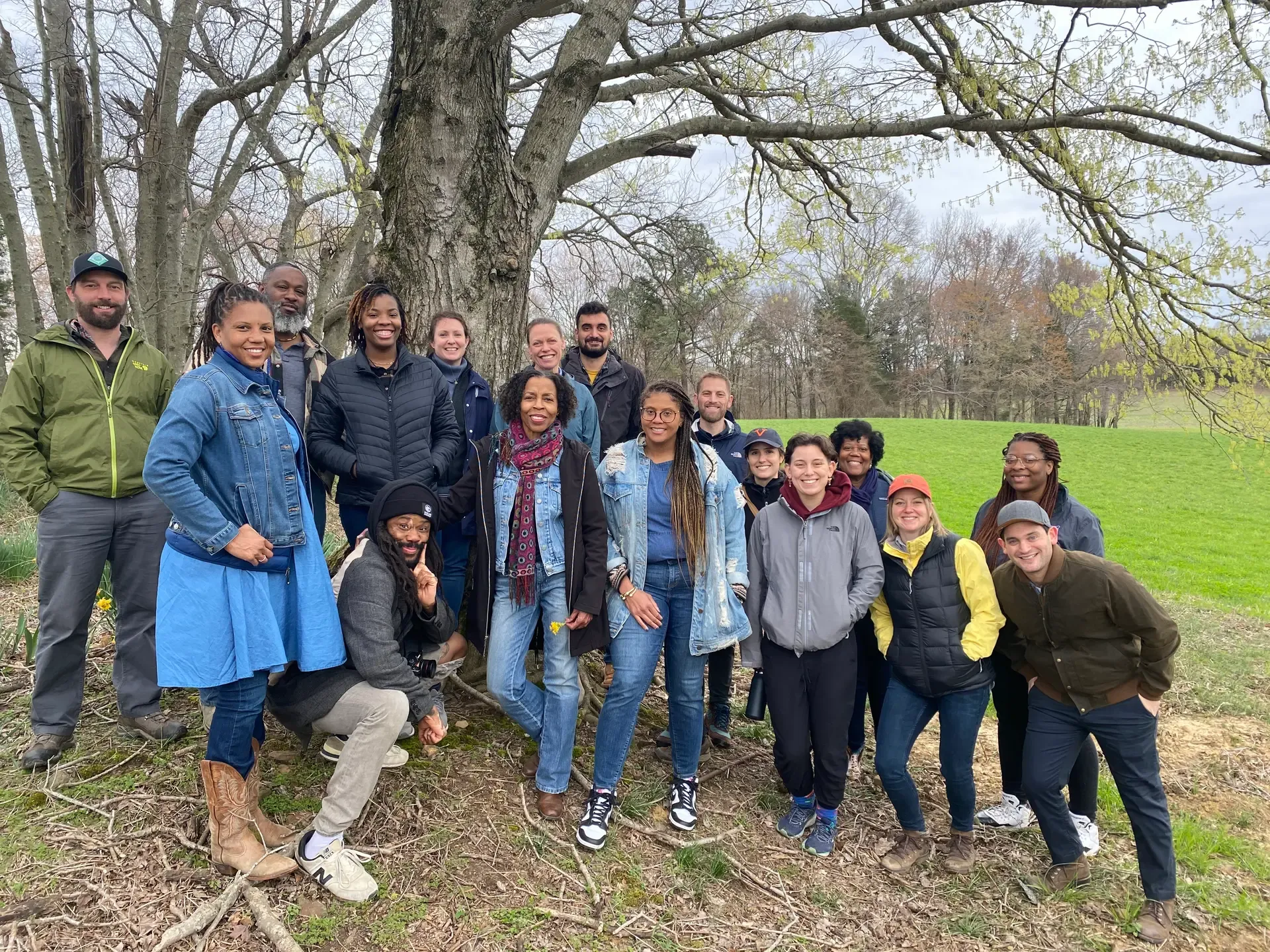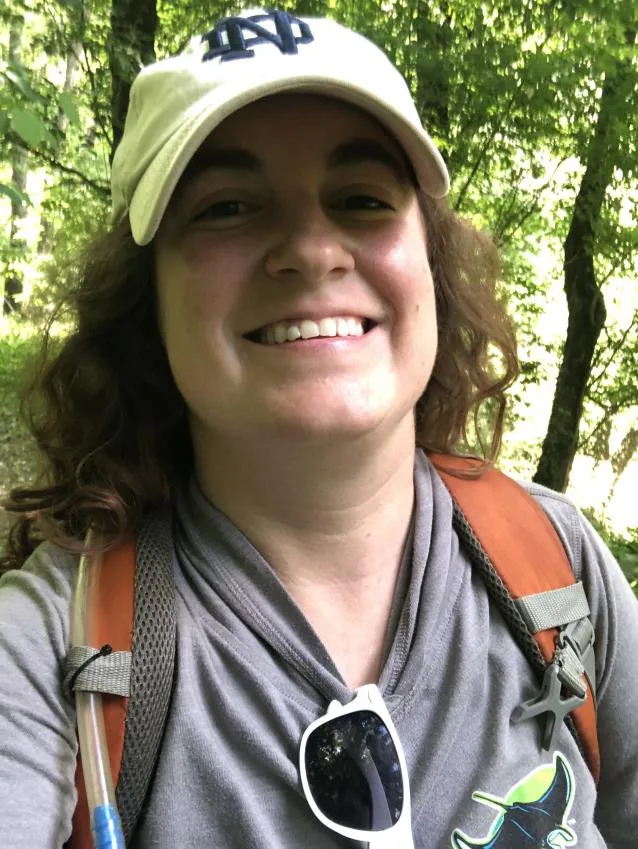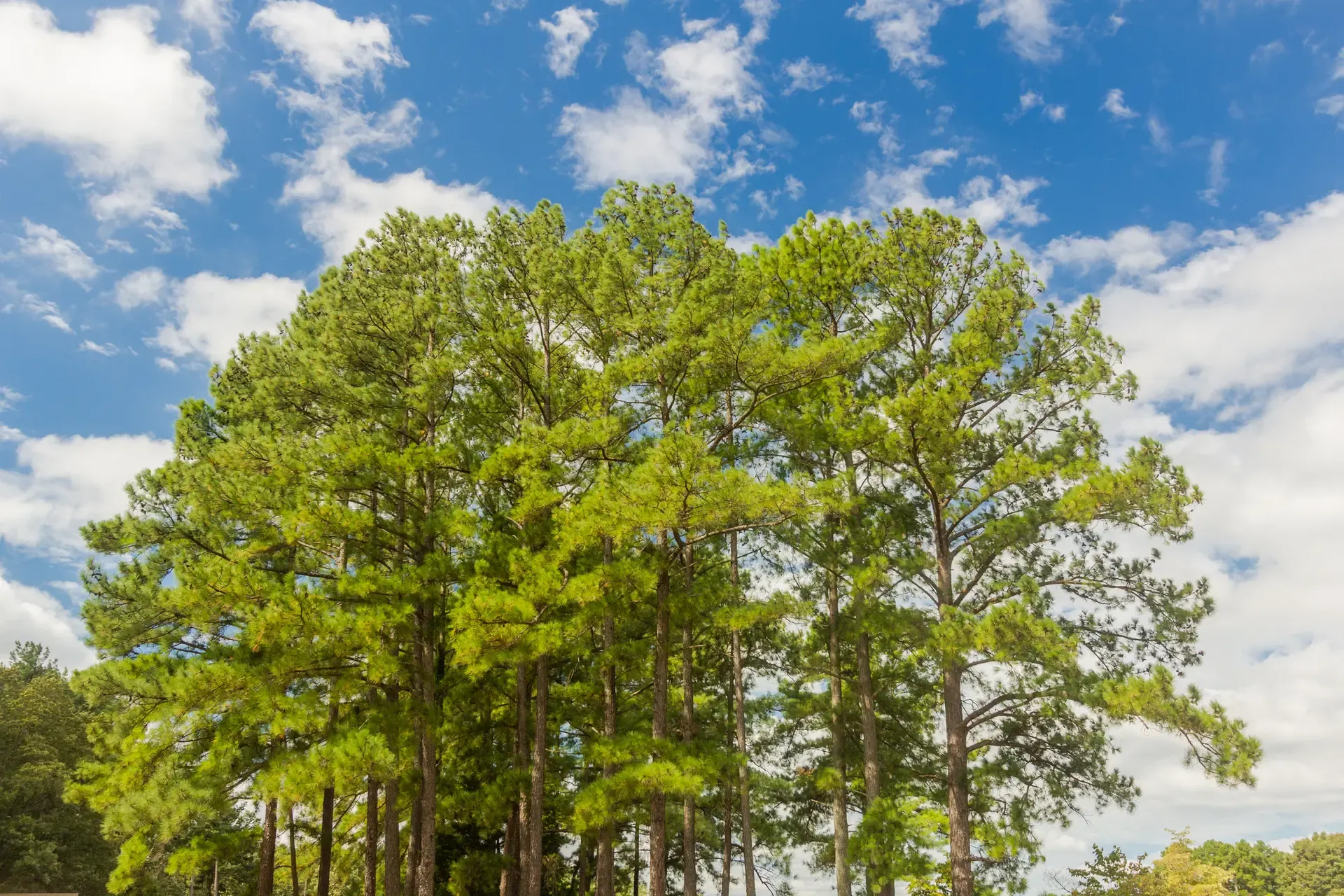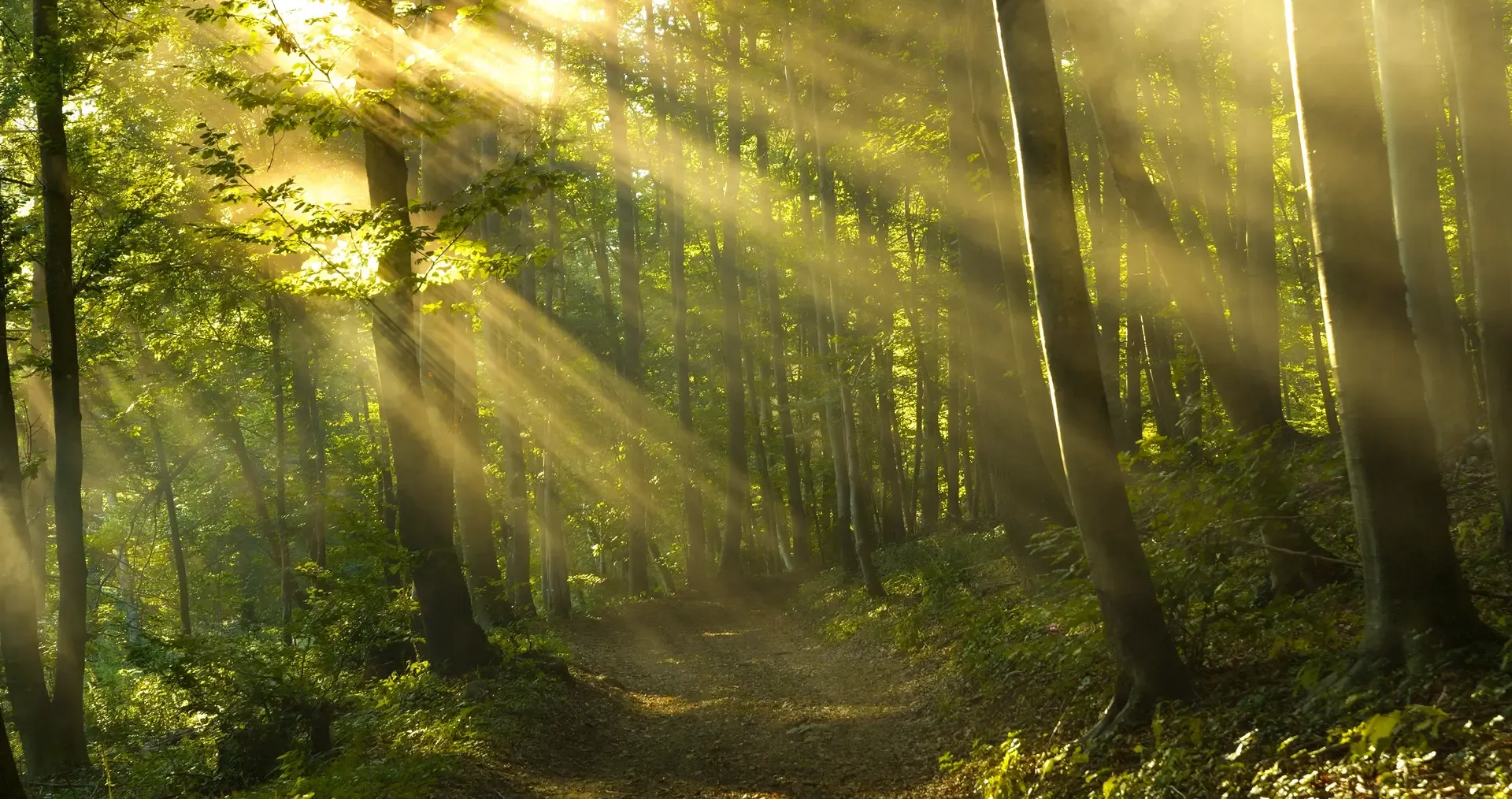Talking about Diversity, Equity, Inclusion and Justice in the Family Forest Carbon Program

American Forest Foundation staff visits the Moore Family Farm in Benton County, Tennessee, at a gathering hosted by landowner Renee Williams.
At the American Forest Foundation, we know that partnering with America's family forest owners can yield huge benefits for families, communities, and the planet. That's why it's critical that our work removes barriers to opportunities, like the voluntary carbon market, and expands access for all landowners from all walks of life.
In March, the American Forest Foundation held its first Diversity, Equity, Inclusion, and Justice Summit in Memphis, Tennessee. The event was spearheaded by the Director of DEIJ for the Family Forest Carbon Program, Dr. Tatiana Height, and convened 24 AFF staff members from across the organization, as well as organizational partners, landowners, and a board member.
The purpose of the Summit was to orient the team about what it means to do DEIJ work by reflecting on DEIJ as a whole, recalling the effectiveness of past organizational DEIJ strategies, and ideating about areas of need in our DEIJ work. As a part of the summit, participants had an opportunity to reflect on their own DEIJ journeys, as well as reflect on the progress AFF has made on its DEIJ initiatives. Importantly, the Summit was a time to acknowledge missteps—and have open conversations about how we can live up to the values we espouse and accomplish our organizational goals.
Over three packed days, this group worked on setting and defining the objectives and actions necessary to place a DEIJ lens on our existing forest management practices and future endeavors that are in discovery or being piloted.
As we reflect on the Summit, Dr. Height shared some insights on the DEIJ work that AFF, FFCP, and its partners must do to embody our values and pursue environmental justice.
Why is it so critical to engage and support underrepresented landowners?
We know these things are problems, so how can we get involved in being part of solving them?
I always say, why would you want to be part of the problem when you can be part of the solution? We acknowledge there is a huge disparity for marginalized landowners when it comes to land ownership, when it comes to engaging in carbon markets, and when it comes to their experiences in the forest product industry. However, just acknowledging really isn’t much. We need to actually do something. We know these things are problems, so how can we get involved in being part of solving them?
Carbon markets have historically served large landowners and organizations. We created a program that was designed to make carbon markets accessible to family forest owners. So, the next step is to go further than that. The people who have been participating in our program to-date have been largely homogeneous in terms of demographics—men and women who are typically 65+, upper middle class, and white—, so how can we go even further and be inclusive for individuals that come from marginalized backgrounds? From an environmental justice perspective, we need to make sure that our environmental programs, and the benefits associated with them, are accessible to people from marginalized populations.
We are trying to deal with this huge issue that is the climate crisis. And if we're really serious about addressing the crisis, then we need to do everything we can. If there’s a notable sector of landowners who are not being included in mitigating the climate crisis, then we’re not doing everything we can, and we can’t ignore that whole sector of landowners.
What are the challenges that many landowners from marginalized groups face?
Most small landowners—regardless of race, ethnicity, or income—face challenges in terms of navigating government policy and accessing services from vendors. But when it comes to underserved landowner groups, it's a whole different ballgame. You’re now not just dealing with the ramifications of what’s going on with the forest product industry in general, or carbon markets in general, or policy in general, you’re also layering on the experience of social dynamics. In addition to all the issues that face landowners, you’re intersecting implicit biases or microaggressions or other experiences of that nature, creating a unique experience for underserved landowners.
Depending on what marginalized group we’re talking about, there are different challenges
It also varies depending on what group we’re talking about. The landowner experience is not going to be the same for all ethno-racially minoritized groups.
Indigenous landowners, for example, have a unique history with respect to the colonization of their lands. They’ve had the experience of being told they have sovereignty, but then not having that sovereignty respected. They’ve been offered lands, or offered lands back, and then had those lands taken again; or experienced certain activities that are in essence taking the land back by the way their land is treated.
Black landowners have their own unique experience too. For instance, a lot of times heirs' property is a big issue. Or they have faced predatory appraisers who have undervalued their land or offered Black landowners less for their trees than they should have. We see that funding is not offered at the rate that it should be in terms of federal government programs. Why do some federal government programs have huge amounts of money for general programs, and then much smaller pots of money available specifically for marginalized groups? We see discrimination in USDA loans throughout history for Black landowners. And we’ve seen that when Black landowners are able to acquire land and move into regions that have traditionally been more racially homogenous, they are faced with racism and attempts to displace them from their land.
Or if we’re talking about immigrant populations, they often face issues with perceptions. People make assumptions around their citizenship status or languages they speak and they face racialized experiences.
Historically, we’ve seen imminent domain being used as a tool to take land from marginalized communities. For instance, the placement of highways often specifically and deliberately went through Black and Brown communities to break them up. Similarly, development pressures have happened and are continuing to happen that cause land loss. We’ve seen sub-prime loans offered to marginalized people, even people whose credit profile does not warrant a sub-prime loan. These crazy interest rates and fees that are impossible to keep up with are used as a strategy to take land from Black and Brown folks.
There’s also been a history of segregating where people can or cannot live. Redlining gets talked about a lot—a practice where lenders claim certain areas are risky, which results in highly segregated communities. But besides redlining, another challenge is restrictive covenants—putting rules on the land that says who can or cannot live on or own land in a certain place. Some of those restrictive covenants are still in place today. And given how long these things were put in place, some for 100 or 200 years, we’re still dealing with the effects.
So, depending on what marginalized group we’re talking about, there are different challenges. It means that we, at AFF, need to be knowledgeable and responsive to those experiences, and hopefully create a holistic approach to dismantling and addressing the variety of unique challenges.
Can you share some insights into the work that you’re doing in the DEIJ space, as our DEIJ Director and as it relates to FFCP?
We just had our first DEIJ Summit, which included staff representing every team at AFF. This was a space for us to talk about what it is that we want to achieve, as it relates to DEIJ, and to get on the same page about what this work could be. My role is new, something we’ve never had before, and people have different ideas of what it means. There will be many more conversations to come, but it was important for us to start having that conversation.
The key task for us is removing barriers to participation in our program, making it more inclusive and accessible for people who are currently underrepresented. Our program serves some landowners really well, but we have more work to do with other groups.
We need to shift and adjust to make a space that serves groups we haven’t previously served.
We have to do more research to determine why some groups are not as represented as they could be. With that knowledge, we can remove those barriers within the program. This probably means doing some pilot efforts to see what changes we can make and how effective they are. We also need to do trust building work with communities we haven’t traditionally served or focused on. Not just through the Family Forest Carbon Program, but as an organization.
We’re also going to take a more intentional look at where we work. For instance, are there places where the minority is the majority and where we can get in on the ground floor? How can we use information about who is in an area and who we can serve to inform where we expand our program?
There is also going to be some internal work. It’s important for us to have a staff that is representative of the communities we want to serve. For example, landowners look at our website to see who is participating in our program and who comprises our staff, and use that to decide if our organization looks like a place they want to engage with or not. They can see what issues we’re addressing, and what issues are glaringly ignored. They can see the core values that AFF and FFCP espouses, and whether those align with where they are and if we’re the type of organization they want to be intertwined with. We need to take a hard look at ourselves. We need to shift and adjust to make a space that serves groups we haven’t previously served.
Once we remove the barriers to entry, make changes to our culture and how we operate, make it clear that we want landowners from underrepresented groups to be present in our program—that we want our program to be one they are interested and excited about being part of—then hopefully our program will start to diversify. We hope to see The Family Forest Carbon Program starting to at least mirror the way family forest ownership looks by demographics. And then we can really look at the systemic barriers, engaging in policy work more broadly. We want to be looking at the challenges from all angles to get to a place of inclusion, equity, diversity, and justice.
Related Articles

July 1, 2025
Forester Spotlight: Sarah Cawood
We’re excited to highlight Sarah Cawood, a dedicated forester with the Family Forest Carbon Program (FFCP) who brings enthusiasm, experience, and a strong commitment to conservation to her work.

June 3, 2025
Why Wildlife Loves Loblolly—And How These Pines Can Benefit Your Land
A quiet stretch of pine trees can offer more than just scenery—it can provide vital habitat for wildlife across every season. Loblolly pine, the most common native tree species in the Southeast, plays a particularly important role in creating habitat for a wide variety of game and non-game species, from wild turkeys and rabbits to songbirds and squirrels.

May 28, 2025
New Report Details Innovative Approach to Permanence for Natural Climate Solutions
The American Forest Foundation released today “A Trust for Permanence: Enabling a New Generation of Permanent Nature-Based Credits in the Voluntary Carbon Market,” a new concept paper that details an innovative approach to ensuring the quality and integrity of credits produced through natural climate solutions (NCS).